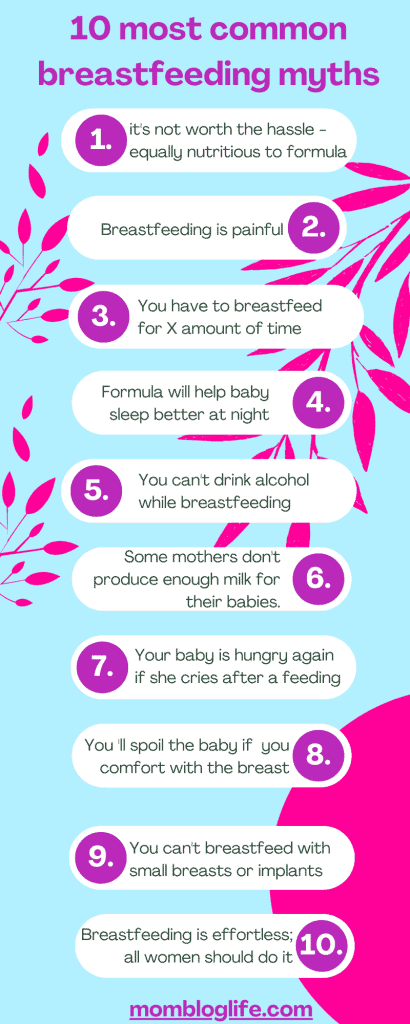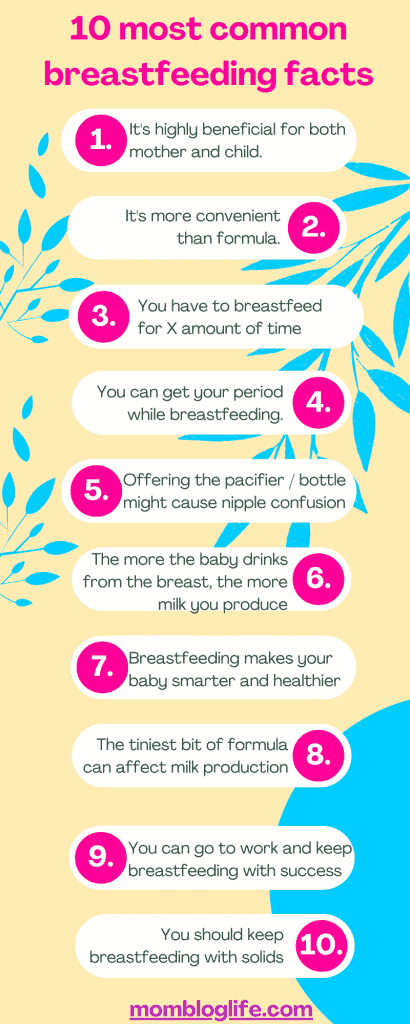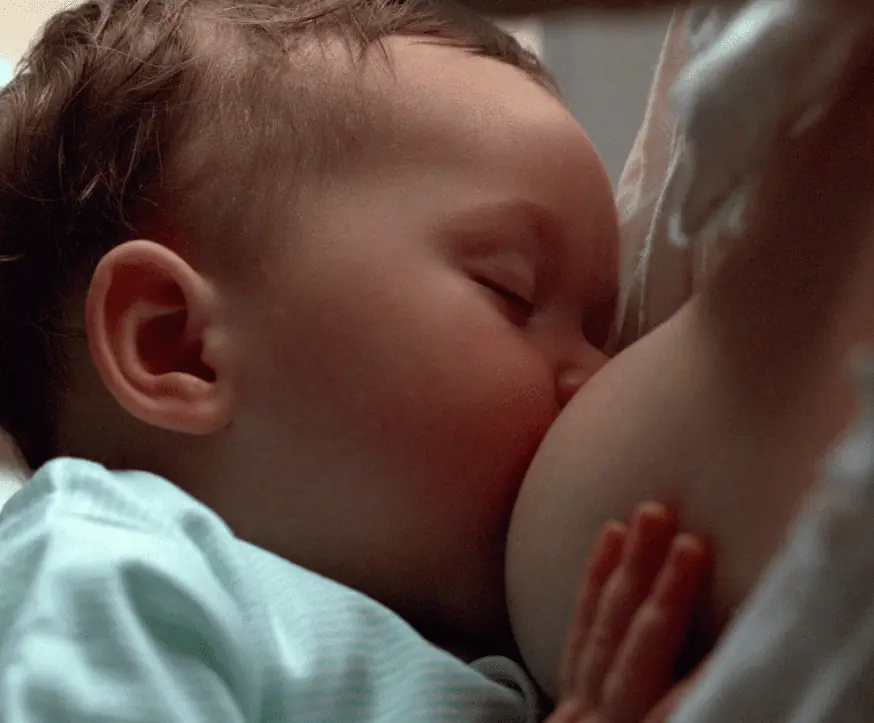10 Breastfeeding Myths and Facts Every Pregnant Woman Should Know
This post may contain affiliate links. As an Amazon Associate, I earn from qualifying purchases.
When I was seven months pregnant, everything was prepared for my little one – clothes, nursery, presents… and then somebody asked me: Are you going to breastfeed?
Until then, I thought there was no such question. Breastfeeding was the natural thing to do. Aren’t all new moms supposed to breastfeed their babies? Well, not necessarily.
Breastfeeding is a choice nowadays- and as you approach the end of your pregnancy, you must arm yourself with all the information about it. Deciding beforehand whether you will start breastfeeding and getting all the help you can, a rigid plan, and a supportive environment is a crucial step.
There are a lot of myths and misconceptions about breastfeeding, so it can be tough to figure out what you can or can’t do, especially when you’re still unsure what’s best for your little one – formula, breast, or mixed nutrition. Knowing what’s true and what’s not and sticking to your plan will make your post-partum life much easier.
Seeing the whole picture and clearing out all the breastfeeding myths and facts will help make your decision about whether or not to breastfeed easier and the overall experience smoother – because breastfeeding, like motherhood itself- is a journey with ups and downs.
Eventually, a lactation consultant advised me – but I wish someone was out there beforehand to offer proper parenting tips and tell me the subjective truth about breastfeeding and every difficulty I’d encounter.
Let’s start with the ten myths about breastfeeding that every mother should know:

1. It’s not worth the hassle; formula-feeding is equally nutritious.
Truth: breastfeeding is worth the hassle – it’s nutritionally superior to formula-feeding, as your breast milk is tailor-made for your baby and adjusts nutritionally to his needs. The texture, quality, and nutrients of your milk keep changing as your baby grows – something which is not happening with formula.
2. Breastfeeding is painful.
Truth: Breastfeeding is not painful if you’re doing it correctly. There might be a bit of discomfort during the first few weeks as your baby learns to latch on properly, but this should go away soon, and you shouldn’t stop nursing.
I used a lanolin cream, and the discomfort stopped after a few days. If breastfeeding continues to be painful, seek help from your healthcare provider, as your baby is probably not latching correctly, which affects his ability to drink milk.
3. You have to breastfeed for X amount of time.
Truth: You can breastfeed for as long or as short as you want, and it’s entirely up to you and your baby. I am still breastfeeding my son, although he has started solids, and I plan to do so until he’s one year or older.
However, most babies only nurse for a few weeks or months, and It’s important to remember that even a tiny bit of human milk has a significant advantage over zero. Although AAP recommends exclusive breastfeeding for the first six months of life and complementary breastfeeding up to two years and beyond, that’s simply a recommendation.
Breastfeeding is a two-way street; there should be no judgment for moms and babies who desire to breastfeed for longer or shorter periods.
4. Formula will help my baby sleep better at night.

Truth: Breastfeeding will help you and your baby sleep better at night. A breastfeeding mom can learn practical breastfeeding positions, such as laying down with the baby nursing on the side. That way, she can pull the baby closer to the breast while she is still sleeping, while the baby feels safe and calm closer to the mom’s warm body.
This incredible trick helped my little one to resettle and fall asleep in a few minutes, offered me more sleep in the beginning when the baby woke up every 2-3 hours to eat at night, skyrocketed my milk supply, and helped with breastfeeding establishment.
And yes, although your baby digests the breast milk faster, that doesn’t mean he sleeps better when formula-fed. Formula is heavier for your baby’s stomach, worsening the reflux at night.
Also, a baby’s stomach is tiny, so they need to eat frequently at night, especially when they are a few weeks or months old, despite being formula-fed or breastfed. While formula-fed, you wake up in the middle of the night, get up, sterilize, prepare the milk, warm it up, and feed the baby. While breastfeeding, you pull the baby close to you, feed, and both fall asleep.
My son (and many breastfed babies I know) hit the six and seven-hour sleep stretch at five/six weeks old.
Sleeping better at night has to do more with your baby’s needs, circadian rhythm, or self-soothing skills rather than the type of milk they drink.
5. You can’t drink alcohol while breastfeeding.
Truth: You can drink alcohol while breastfeeding, but you must be careful about the amount and timing.
According to breastfeeding organizations such as La Leche League International (LLLI), it’s okay to have an occasional glass of wine or beer while breastfeeding. It’s best to wait two hours after one standard drink before breastfeeding your little one.
6. Some mothers don’t produce enough breast milk for their babies.

Truth: Almost all mothers can produce enough breast milk for their babies, regardless of the size of their breasts, and this is one of the most common breastfeeding myths that many women have.
Many reasons might cause a mother to think she doesn’t produce enough milk, especially if the baby is not happy after a feeding.
In most cases, it’s just your baby wanting to be soothed through the breast, reflux, tiredness, baby eating relatively fast and not wanting to spend more time on the breast, incorrect latch, extensive use of pacifiers or bottles, not breastfeeding frequently enough, or just phases that the babies go through, and they reject the breast for no apparent reason.
If you ever encounter such thoughts (because all breastfeeding mothers will think they don’t have enough milk throughout their breastfeeding journey), remember; if your baby has 5-6 wet diapers/day and is gaining enough weight, everything is fine, and she is getting as much milk as she needs.
However, if your baby doesn’t get the appropriate weight, speak to your pediatrician (ensure he is a breastfeeding advocate) and a healthcare professional to figure out what is going wrong before you stop breastfeeding and start feeding your baby formula.
7. Your baby is hungry again if she cries shortly after the feeding.
Truth: There are other reasons why your baby cries, and hunger is not necessarily one of them.
It’s essential to learn your baby’s cues and distinguish between a cry of hunger, a cry of discomfort (wet diaper, too hot/cold), a cry of need for comforting/cuddling, or a cry because of tiredness.
Babies cry, and that’s their only way of communicating with us.
I mistakenly thought that whenever my baby cried, he wanted to eat. Well, that was partially true. He wanted to be cuddled, and he wanted to be in my breast, but just for comfort. And that’s the most natural thing in the world for a baby that’s 40 or 60 days old and still trying to adjust outside the uterus.
Also, there will be many times that your baby will cry because he needs sleep. It is essential to know that and ensure that your newborn’s awake windows (the time they stay awake between naps) can be up to one hour.
Chances are if your newborn stays awake for more than one hour and starts crying, she is overstimulated, overtired, and needs to be soothed to sleep as soon as possible.
8. You’ll spoil your baby if you try to comfort him with the breast.
Truth: There is no such thing as spoiling a baby. Repeat after me: My baby needs me and cannot manipulate me!
Your baby is leaving your uterus’s warm, cozy environment and entering a cold, bright world. Your baby needs to be comforted and cuddled. Breastfeeding provides the best source of comfort for your little one.
I met a bunch of narcissistic, selfish mothers and grandmothers who told me I was going to spoil my newborn if every time he cried, I put him on the breast. This is not true!
It’s entirely natural to comfort your baby by putting her on the breast, especially during the first few months of her life when she is still adjusting to the outside world. Our babies are wired to be close to us, and if your instinct tells you to put him/her on the breast, do it.
I did that with my son for the first 60 days of his life, and I watched him transit from a needy, demanding newborn to a curious, active baby shortly after.
Now, he is using my breast just to eat a few times daily. After a five-minute breastfeeding session, he is ready for his playtime. Don’t let anybody feed you with nonsense opinions, and do what feels right to you.
9. You can’t breastfeed if you have small breasts, flat nipples, or breast implants.
Truth: You can breastfeed regardless of breast size, nipple shape, or implants.
Your baby’s demand determines how much milk your body produces, not the size, nipple shape, or implants of your breasts. Some women with smaller breasts can have excellent milk supply, whereas others with larger breasts might have reduced breast milk production.
A good latch is more important than breast size to produce enough milk for your new baby.
If you have breast implants, that doesn’t affect your ability to breastfeed exclusively. However, the size and place of the implants and the type of breast surgery you’ve had can play a crucial role. If the implants are under the breast fold or through your armpit, you should not have any issues with breastfeeding.
Women with breast implants are usually less likely to exclusively feed their babies with breast milk than women without because of bias, not ability.
10. Breastfeeding is effortless, and all mothers should breastfeed.
Truth: Breastfeeding is not easy, but it’s worth it.
Many factors can affect breastfeeding, from birth interventions and health conditions to many medications taken during pregnancy. Although I’m a breastfeeding advocate, I acknowledge it’s not the best choice for all mothers, and I don’t judge the ones who choose not to breastfeed. Every mother should do whatever feels suitable for her and her baby.
Additionally, some mothers have trouble with latching, flat or inverted nipples, issues with their milk supply, milk ducts, or pain while breastfeeding. I wanted to stop breastfeeding when my baby rejected the breast for no apparent reason or when his weight gain was insufficient.
All these breastfeeding challenges are common, and every mother can overcome them with a supportive environment, help from a lactation consultant, and a strong desire to establish a successful breastfeeding pattern.
Remember, as long as you have a strong desire to breastfeed and persist, you will.
Now, let’s explore ten facts about breastfeeding that every mother should know before giving birth:

1. It’s incredibly beneficial for both mother and child.
Some benefits for the baby: The more you offer the breast in the first days of your baby’s life, the more secure your child becomes. It’s all about attachment.
Breastfeeding has also been linked to a lower risk of SIDS (sudden infant death syndrome). It can help protect babies against some short- and long-term illnesses, like asthma, obesity, or type 1 diabetes. Breastfed babies are also less likely to have health problems, as breast milk has excellent immune protection.
Benefits for the mom: Breastfeeding makes the uterus to contract and return to its pre-pregnancy state, making you look thinner and faster.
While you breastfeed, you lose approximately 500 calories/day. I got 20 kg during my pregnancy, and after four months of exclusive breastfeeding, proper nutrition, and average exercise, I was -18kg. Right, two more to go!
It also reduces the risk of postpartum hemorrhage and ovarian and breast cancer.
2. It’s more convenient than formula feeding.
Breastfeeding is the most natural way to feed your child, and it’s also more convenient than formula feeding. You don’t have to sterilize bottles or worry about carrying around formula powder and water.
You have the milk ready at the correct quantity, quality, and temperature, anywhere, anytime.
3. It’s more affordable than formula feeding.
Infant formula is expensive, and it’s not always covered by insurance. In the US, for example, a can of formula costs around $30, and a breastfeeding mother spends approximately $1,500 less in the first year than a formula-feeding mother.
Why not invest $1500 in something else for your baby rather than cow milk? You have all the food she needs in your breast for her first six months of life. Take advantage of it.
4. You can get your period while breastfeeding.
It’s not unusual to experience an irregular menstrual cycle or no period while breastfeeding exclusively. This is called amenorrhea, and it’s perfectly normal. Most women who breastfeed exclusively get their period for the first time post-Partum six or twelve months after birth, when breastfeeding sessions are reduced due to solids.
Amenorrhea results from the high levels of prolactin in your body (the hormone responsible for milk production). Your body is working to produce breast milk for your little one instead of ovulating -for another little one- again.
The good news is that amenorrhea can help reduce the risk of uterine and ovarian cancer, and you enjoy some time without worrying about blood, pads, or getting pregnant again.
However, there are some unfortunate women (including me) that get their periods on the first, second, or third month post-partum, even when breastfeeding exclusively. I gave birth in March and got my first period in April, which means I could technically get pregnant again.
However, I had a one-month-old baby exclusively breastfed baby, so I had to think about birth control on top of everything else.
5. Offering the pacifier and the bottle in the early days might cause nipple confusion.

If you want to introduce a pacifier, wait longer than four weeks until breastfeeding is well-established and choose a breastfeeding-friendly pacifier, to ensure a greater supply for your little one.
The same applies to bottles.
Your baby must get used to latching on and sucking from the breast first. Then, you can start pumping, and offering expressed milk in a bottle a couple of times per week so your baby gets used to it and you don’t have to worry about leaving her with a babysitter.
I didn’t give my son a pacifier until he was one month old, and I introduced the bottle at six weeks when breastfeeding was well-established and we were both comfortable with it.
6. The more the baby drinks from the breast, the more milk you produce.
It’s true that the more your baby drinks, the more milk you produce. This is because of the let-down reflex triggered by your baby’s sucking.
The let-down reflex releases oxytocin in your body, which makes the muscles around your breast contract and pushes the milk towards your nipple.
The more your baby sucks, the more oxytocin is released, and the more milk you produce.
You can help trigger the let-down reflex by thinking about your baby or by touching your breast while she’s breastfeeding.
7. Breastfeeding helps your baby to become more intelligent and healthier.

Many studies show the benefits of breastfeeding for babies.
Breastfeeding has been linked to higher IQ scores, better academic achievement, and healthier babies.
Breastfeeding is so beneficial because it’s packed with nutrients essential for your baby’s development, such as DHA (an omega-3 fatty acid), vital for your baby’s brain development.
Breastfeeding has also been linked to a reduced risk of obesity, respiratory infections, and ear infections.
So if you can breastfeed, do it! It’s not only good for your baby but also good for you, as mentioned above.
8. The tiniest bit of formula can affect your milk production.
If you’re breastfeeding and you give your baby formula, even just once, it can affect your milk production.
This is because when you give your baby formula in a bottle, she doesn’t have to work as hard to get the milk out, so your body produces less milk. Also, formula milk is heavier for your baby’s stomach than breast milk, which your baby digests after approximately one hour.
Therefore, she might be more full than she’d be if she only had breast milk, which might reduce the time she spends on the breast, which will reduce your milk production.
So if you can, try to avoid giving your baby formula, even if it’s just once.
9. You can go to work and keep breastfeeding with success.
You can absolutely go back to work and keep breastfeeding.
You will need to pump milk during the day so that your baby has milk to drink while you’re away, and you’re also keeping your milk production intact by replacing a breastfeeding session with a pumping session.
Make sure breastfeeding is well-established before introducing your milk into a bottle.
Pumping is not as hard as it seems, and there are many ways to make it easier, such as using a hands-free pumping bra or investing in a good quality pump, preferably a double electric one.
Pumping milk might take some getting used to, but it’s definitely doable, and there are many resources to help you, such as breastfeeding support groups and lactation consultants.
10. You should combine breastfeeding with solids after the 5/6 months of your baby’s life.
You can start introducing solids to your baby after she’s around 5 or 6 months old.
Before that, her stomach is too small, and she doesn’t have the necessary muscles to chew and swallow food properly.
Also, her immune system isn’t fully developed yet, so she’s more prone to infections if she eats solids too early.
You can start by breastfeeding your baby as usual and then offer her a small amount of pureed or mashed food.
Gradually increase the amount and the frequency of solid foods until she’s eating three meals a day.
But even after you start giving her solid foods, continue breastfeeding her, as breast milk is still the best food for her.
The takeaway.
Breastfeeding is one of the most natural things a woman can do for her child, yet it’s also one of the most controversial. After reading this article, I hope you better understand breastfeeding and some of the myths and facts surrounding it.
If you want to breastfeed your baby, I encourage you to do so – it’s one of the best things you can do for your child. And if you can’t or don’t want to breastfeed, know there are plenty of other ways to provide your child with all the nourishment she needs.
Maria is a Greek girl passionate about traveling, self-development, and everything related to digital marketing. She has been moving around the world for the last four years and shares her thoughts & pieces of advice on personal growth, travel & remote working at triggeryourtrip.com.




